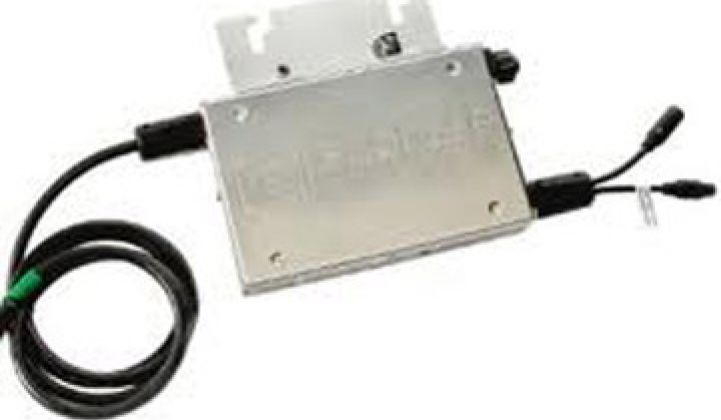Petaluma, Calif. --- In June, Enphase Energy is going to start stringing up solar panels like track lighting.
The microinverter manufacturer will come out with a third-generation product this June, said executives during a briefing at its headquarters in Petaluma this week. The microinverter will achieve a 96 percent conversion efficiency, a boost from the 95 percent efficiency on the current products. But more importantly, the new product will save labor.
The new inverters will allow solar panels to easily be wired up on a trunk line. Imagine a line of solar panels. Each will have a microinverter attached to them. A rat-tail cable will extend from the microinverter that will get connected to a trunk line that can be cut to length.
The Lego style of wiring cuts the labor involved in wiring up microinverters by 60 percent to 70 percent according to one installer (as reported by Enphase), and microinverters already cut labor by around 15 percent over centralized and string inverters. Less labor, less cost, better for solar.
Later in the year, the company will show off what could become the showcase for its push into commercial installations, a three-chip inverter. (Co-founder Raghu Belur mentioned the three chip solution at the Solar Summit 2011 earlier this month.)
Right now, Enphase’s microinverters are based around a single piece of silicon that converts power from DC to AC, communicates via a proprietary power line networking link to a DSL box and generally controls the solar system.
Enphase wouldn’t say what the three separate chips would do, but it likely would fall along these lines. Separating the communication link from the DC-AC converter would allow Enphase to substitute different communications protocols (industrial-grade Wi-Fi, standard versions of power line) for its own power line protocol. Enphase isn’t married to its communication stack -- it invented the technology because it couldn’t find an adequate solution in the company’s early days. The power line link only serves to connect a microinverter to a broadband gateway: it doesn’t communicate directly to the wider world.
Mixing and matching capabilities would allow the company to expand the variety of inverters it sells. (Again, we’re guessing here.) Enphase did not say what the three chips would do. Two executives indicated that the three-chip product would be destined for the commercial market, but they didn’t definitively announce a product. However, this makes sense. (Historical note: ‘convert, communicate, control’ was also the business model of the Spanish Inquisition. Probably just a coincidence.)
The emphasis on chips, if anything, helps underscore how Enphase and microinverters in general represent a major departure in solar. You may not buy the argument, but it is pretty compelling. Traditional inverters are largely hand-built pieces of equipment with lots of copper and other raw materials. The heart of a microinverter is a circuit board that inexorably gets faster, cheaper and smaller over time.
“It is not just a small inverter. You can’t take a regular inverter and shrink it,” said CEO Paul Nahi. “The technology is vastly different.”
If you want an analogy for Enphase, it is handy to think of it as a hybrid of Texas Instruments, Salesforce.com and Agilent. Like TI, a significant part of the business model revolves around designing and enhancing digital signal processors. Enphase effectively designs chips, but then sells them as microinverters.
The Salesforce.com part comes in monitoring and service. The company’s support group tracks the ongoing performance of the 500,000 plus microinverters planted at 20,000 plus sites. The microinverters send data every 5 minutes. Approximately 15 to 18 GB of data gets delivered from the field to the company, including data about operating temperature, potential failure and solar module performance.
Belur noted that roughly half of Enphase’s engineers are software engineers, a somewhat high number for a hardware company.
With the data, the company can help installers and customers pinpoint problems and determine their cause. While the service is free to installers now and for a few dollars a month for end-users, Enphase is studying ways to monetize it further. One could imagine the company linking up with demand response providers or utilities: the precise monitoring would be valuable information in peak power incidents. Petra Solar already combines microinverters with smart grid monitoring capabilities.
“We are starting to look a little bit wider now” at ways the company's Enlighten data service can be used, said Nahi.
Suggested motto: Silicon as a Service.
The Agilent part comes in the testing that the company conducts. To get past the skepticism in the market about microinverters, the company had to amass reams of reliability and performance data. Approximately 30 percent of the engineering staff, hardware and software, work in quality assurance and testing.
Existing customers, mountains of real-world and simulated performance data, channel relationships with large module makers and electrical contractors like Siemens, and a battle-tested quality assurance department: these are hurdles that competitors will have to leap over and in part explains the confidence the company seems to radiate. The inverter market is growing at 28 percent a year, said Nahi, citing iSuppli numbers, but microinverters are growing at 164 percent.
Enphase is adding about 100 installers a month and soon some of the large ones, like SolarCity, could become allies.
Competition, though, is coming. SolarBridge Technologies, among others, will soon come to market and some of them will tout longer warranties on their microinverters. SolarBridge has a 25-year warranty compared to Enphase’s current 15. Solar module makers will no doubt bargain one off of the other. The SolarShot program sponsored by the Department of Energy wants to lower the cost of solar electronics to ten cents per watt -- not a lot of wiggle room.
And other companies such as Tigo Energy are developing chips to enhance central inverters. Expect to see Echelon, the power line grand champion, working with microinverter companies to enhance their products.
It will get ugly, but for now Enphase can take a bow for its accomplishments.



